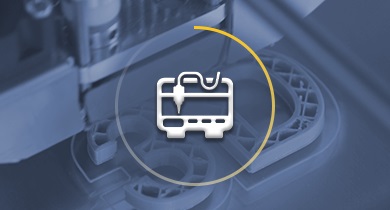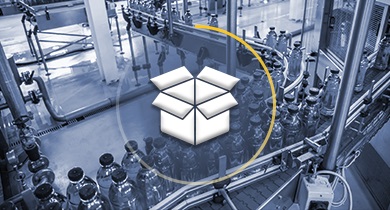- Material
- Hole Machining
- Surface Treatment
- Height H(mm)
- 100
- Dimension A(mm)
- 100
- Type
- CAD
- 2D
- 3D
- Dias de envio estimados
- Tudo
- Dentro de 9 dias úteis
Angle brackets / through hole, parallel pin bore / aluminium, steel / welded-on rib (IKYSAB100-100)
Desenho de contorno e tabela de especificações

| Type | [M] Material | [S] Surface Treatment | |
| No Hole | Hole Positions Configurable | ||
| IKYSB | IKYS | EN 1.0038 Equiv. | Black Oxide |
| IKYSAB | IKYSA | EN AW−5052 Equiv. | — |
Specification Table
| Part Number | — | A |
| IKYSB100 | — | 100 |
| Part Number | — | A | — | B | — | X | — | F | — | Y | — | G |
| IKYS120 | — | A100 | — | B75 | — | X40 | — | F30 | — | Y40 | — | G50 |
| Part Number | A | W | T | T1 | E | |
| Type | H | |||||
| IKYSB IKYSAB | 100 | 50 | 100 | 10 (10) | 9 (10) | 65 |
| 100 | ||||||
| 120 | 100 | 80 | ||||
| 150 | 100 | 100 | ||||
| 200 | 60 | 135 | ||||
| 100 | ||||||
| 250 | 60 | 14 (13) | 12 (12) | 165 | ||
| 100 | ||||||
| 300 | 100 | 200 | ||||
| 350 | 120 | 235 | ||||
| 400 | 150 | 20 (23) | 16 (15) | 265 | ||
| 500 | 150 | 335 | ||||
■Hole Position Configurable
| Part Number | A | 1 mm Increments | Fixed Dimension | ||||||||||||
| B | X | F | Y | G | W | T | T1 | E | a | h | D | d | |||
| Type | H | ||||||||||||||
| IKYS IKYSA | 100 | 50 | 50 to 75 | 30 to 35 | — | 35 to 55 | 30 to 50 | 100 | 10 (10) | 9 (10) | 65 | X+ (F/2) | Y+ (G/2) | 10 | 11 |
| 100 | 30 to 55 | 30 to 55 | |||||||||||||
| 120 | 100 | 35 to 75 | 30 to 70 | 80 | |||||||||||
| 150 | 100 | 35 to 105 | 30 to 100 | 100 | |||||||||||
| 200 | 60 | 35 to 45 | — | 35 to 155 | 30 to 150 | 135 | |||||||||
| 100 | 35 to 55 | 30 to 50 | |||||||||||||
| 250 | 60 | 35 to 45 | — | 50 to 205 | 30 to 185 | 14 (13) | 12 (12) | 165 | |||||||
| 100 | 35 to 55 | 30 to 50 | |||||||||||||
| 300 | 100 | 50 to 255 | 30 to 235 | 200 | |||||||||||
| 350 | 120 | 40 to 75 | 30 to 65 | 50 to 305 | 30 to 285 | 235 | |||||||||
| 400 | 150 | 40 to 105 | 30 to 95 | 50 to 355 | 30 to 335 | 20 (23) | 16 (15) | 265 | |||||||
| 500 | 150 | 50 to 455 | 30 to 435 | 335 | |||||||||||
Alterations

| Part Number | — | A | — | B | — | X | — | F | — | Y | — | G | — | (NKC·LN・HN・MC) |
| IKYS120 | — | A100 | — | B75 | — | X40 | — | F30 | — | Y40 | — | G50 | — | NKC |
| Alterations | Omit Dowel Holes | Slotted Hole | Tapped Hole | ||||||||||||||||||||||||||||||||||||||||||||||||
 |  |  |  | ||||||||||||||||||||||||||||||||||||||||||||||||
| Code | NKC | LN | HN | MC | |||||||||||||||||||||||||||||||||||||||||||||||
| Spec. | Omits all dowel holes. Ordering Code NKC | Changes the d holes on A surface to slotted holes. Ordering Code LN [ ! ] When A = 50 or 60, two slotted holes are machined. [ ! ] When A = 50, the slotted hole length is 10 mm. | Changes the d holes on H surface to slotted holes. Ordering Code HN [ ! ] When H = 100, 120 or 150, the slotted hole distance is 20 mm. | Changes the holes 4-d (ø11 Through Holes) on side H to tapped holes M10. Ordering Code MC | |||||||||||||||||||||||||||||||||||||||||||||||
| * There is no dowel hole on the slotted hole side. |
| * There is no dowel hole on the slotted hole side. |
| ||||||||||||||||||||||||||||||||||||||||||||||||
Informações detalhadas
Informações básicas
Welded spacers where you can freely choose the spacing of the fixing holes. You can also choose the type without holes.
Contorno e especificações
General Information - Angle Brackets

Angle Bracket Selection Details
- Material: aluminum, steel, cast steel, stainless steel
- Coatings: untreated, burnished, primed (grey), nickel-plated
- Design: cast, welded
- Perpendicularity: up to 0.02/100
- Bore holes: without bore hole, through-hole, internal thread, dowel pin bore, oblong hole
- Dowel pin bore: H7
- Length A: 40 to 150 mm
- Length H: 50 to 500 mm
- Width: 30 to 100 mm
Description/Basics
Basically, an angle bracket is used for precise and solid fastening or connecting of different components and as frame constructions in mechanical and plant engineering. In most cases, angle brackets are uneven.
Due to its high perpendicularity, an angle bracket is among the precise mounting angles. Thanks to their stiffening rib, the angle bracket is also more solid and stiffer than conventional mounting angles and offers a precise, robust and secure connection.
MISUMI offers angle brackets with configurable through holes and dowel pin bores. The through hole can be converted to a tapped hole using the [MC] option. In addition, with the help of the option [LN, HN], the through hole of the angle brackets can be changed to an elongated hole. The angle bracket itself or the element to be fastened can thus be adjusted. The optional dowel pin holes in conjunction with dowel pins offer the possibility of aligning and mounting components such as manual stages, cylinders or other devices as accurately as possible on an angle bracket.
Our angle brackets are also available as blanks without mounting holes for individual machining.
Due to the many variations of an angle bracket, it offers design flexibility. This allows adapting it to the machine environment. With MISUMI, you can configure and have your steel brackets customized or stainless steel angles customized.
Angle brackets are often used as cylinder holders for air cylinders, as the exact straightness and exact position of the dowel pin bores allow for exact positioning of the cylinders. An angle console is also suitable for holding and holding positioning stages. Occasionally, the angle bracket is also used in clamping technology to accommodate the push-pull toggle clamps, clamp cylinder or gripper.
MISUMI offers for assembly different threaded rods and nuts, as well as washers.
Steel angle bracket/steel bracket
The benefits an angle bracket made of steel (cast steel) provides are primarily its high strength and the load capacity of the base material. As a result, steel angle brackets can absorb high loads.
Since steel has good quality, it is less expensive to manufacture, easy to rework and welds well. Compared to many other metallic raw materials, steel is quite cost-effective and can therefore be found in many applications.
Thanks to its good thermal conductivity, a steel angle or steel angle bracket can be used in areas with high temperatures. Since steel tends to oxidize, a coating should be provided as much as possible depending on the angle bracket. For this purpose, you can choose between either burnished, nickel-plated or primed.
Stainless steel angle bracket/stainless steel bracket
Angle brackets made of steel or stainless steel are characterized by their high durability. Thanks to their resistance, stainless steel angle brackets are very robust and stable. They are less prone to corrosion because the chrome content forms a passive layer (oxide film). Especially in corrosive environments, it is possible to use an angle bracket made of stainless steel (stainless steel), since the base material is very high-quality. Stainless steel also has high temperature resistance and can be welded. However, at higher temperatures, or even when welding the material, discoloration can occur (tempering colour). The stainless steel angles are also hygienic due to the material and are often used in medical technology.
Aluminum angle bracket/aluminum bracket
An important advantage of aluminum angle brackets is their reduced weight compared to steel or stainless steel angle brackets. This special feature can contribute to weight reduction in many applications. With regard to the low weight, the aluminum angle brackets have by comparison a high strength and can withstand high loads.
In addition, the simple processing and post-processing of the material makes the aluminum angle consoles cost-efficient. Similar to stainless steel, aluminum forms an oxide film and is thus well protected against corrosion. Another advantage of the angle bracket made of aluminum is that the base material has a low thermal expansion. This allows these angle consoles to be used in applications that are subject to frequent temperature changes. Angle consoles made of aluminum also have good electrical conductivity and can thus dissipate electrical voltages such as electrical static charges. This is often necessary in electrical systems or in the electronics industry for the production of electronic components.
Application Examples - Angle Brackets
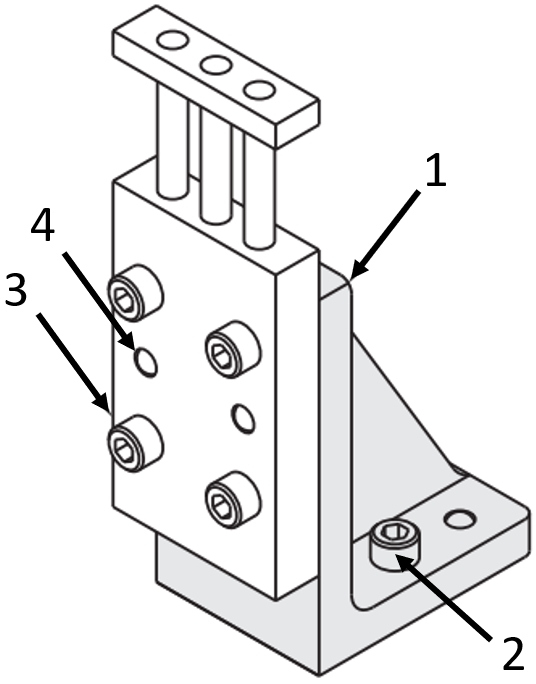
Application example: angle bracket with guide cylinder
(1) Angle bracket, (2) Hexagon socket screw, (3) Air cylinder, (4) Dowel pin
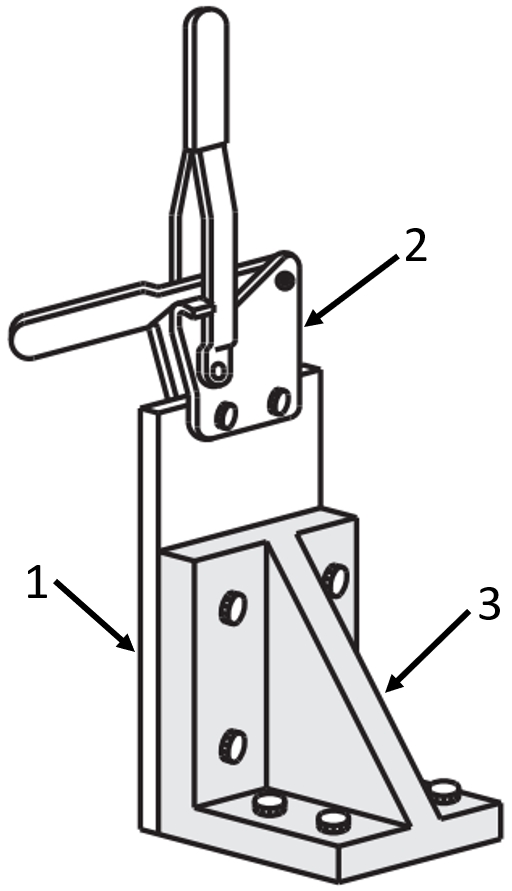
Application example: angle bracket with push-pull toggle clamps
(1) Mounting plate, (2) push-pull toggle clamps, (3) angle bracket
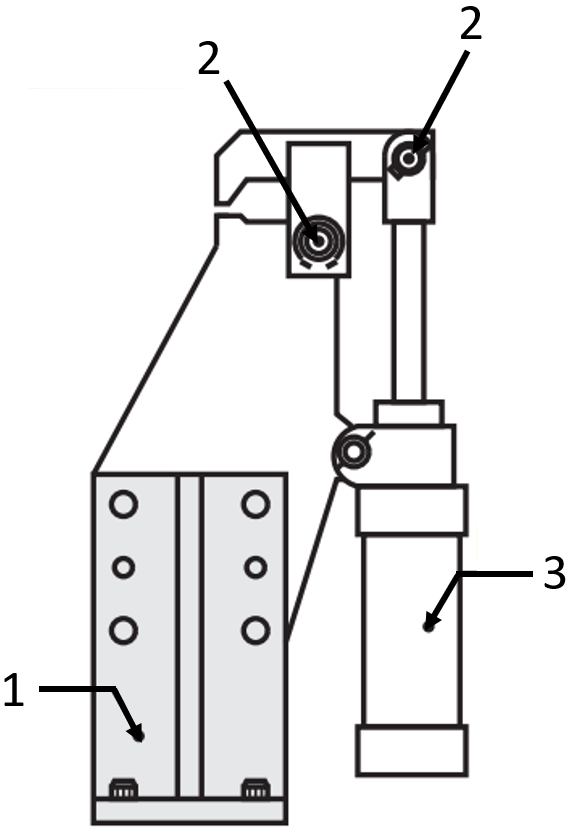
Application example: angle bracket with cylinder
(1) Angle bracket, (2) hinge bolts, (3) cylinder
Industrial Applications
